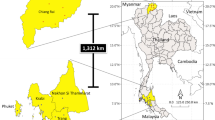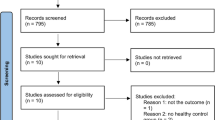Abstract
There is some evidence showing that genetic factors are involved in human susceptibility to parasitic diseases such as schistosomiasis and malaria. Studies have shown that the Nramp1 and H-2 genes are implicated in the control of Leishmania donovani infection in mice. We sought genetic loci involved in the control of susceptibility to visceral disease caused by L. donovani in humans. We studied 37 families with at least two affected sibs living in a village in eastern Sudan, where an outbreak of visceral leishmaniasis occurred between 1995 and 2000. The genetic markers located in five chromosomal regions containing candidate genes were typed: 2q35 (NRAMP1), 5q31–q33 (Th2 cytokine cluster), 6p21 (HLA/TNF-α), 6q23 (INFGRI) and 12q15 (INF-γ). Linkage (multipoint lod-score=1.08; P=0.01) was observed for the 5′(CA) repeat polymorphism in the NRAMP1 promoter. This suggests that genetic variations of this gene affect susceptibility to visceral leishmaniasis in this population.
This is a preview of subscription content, access via your institution
Access options
Subscribe to this journal
Receive 6 digital issues and online access to articles
$119.00 per year
only $19.83 per issue
Buy this article
- Purchase on Springer Link
- Instant access to full article PDF
Prices may be subject to local taxes which are calculated during checkout
Similar content being viewed by others
Accession codes
References
Abel L, Dessein AJ . The impact of host genetics on susceptibility to human infectious diseases. Curr Opin Immunol 1997; 9: 509–516.
Lainson R, Shaw JJ, Silveira FT . Dermal and visceral leishmaniasis and their causative agents. Trans R Soc Trop Med Hyg 1987; 81: 702–703.
Zijlstra EE, el-Hassan AM, Ismael A, Ghalib HW . Endemic kala-azar in eastern Sudan: a longitudinal study on the incidence of clinical and subclinical infection and post-kala-azar dermal leishmaniasis. Am J Trop Med Hyg 1994; 51: 826–836.
Desjeux P . The increase in risk factors for leishmaniasis worldwide. Trans R Soc Trop Med Hyg 2001; 95: 239–243.
Blackwell JM . Genetic susceptibility to leishmanial infections: studies in mice and man. Parasitology 1996; 112: S67–S74.
Gorham JD, Guler ML, Steen RG et al. Genetic mapping of a murine locus controlling development of T helper 1/T helper 2 type responses. Proc Natl Acad Sci USA 1996; 93: 12 467–12 472.
Vidal S, Tremblay ML, Govoni G et al. The Ity/Lsh/Bcg locus: natural resistance to infection with intracellular parasites is abrogated by disruption of the Nramp1 gene. J Exp Med 1995; 182: 655–666.
Plant J, Glynn AA . Genetics of resistance to infection with Salmonella typhimurium in mice. J Infect Dis 1976; 133: 72–78.
Gros P, Skamene E, Forget A . Genetic control of natural resistance to Mycobacterium bovis (BCG) in mice. J Immunol 1981; 127: 2417–2421.
Skamene E, Gros P, Forget A, Patel PJ, Nesbitt MN . Regulation of resistance to leprosy by chromosome 1 locus in the mouse. Immunogenetics 1984; 19: 117–124.
Blackwell J, Freeman J, Bradley D . Influence of H-2 complex on acquired resistance to Leishmania donovani infection in mice. Nature 1980; 283: 72–74.
el-Hassan AM, Zijlstra EE, Ismael A, Ghalib HW . Recent observations on the epidemiology of kala-azar in the eastern and central states of the Sudan. Trop Geogr Med 1995; 47: 151–156.
Ibrahim ME, Lambson B, Yousif AO et al. Kala-azar in a high transmission focus: an ethnic and geographic dimension. Am J Trop Med Hyg 1999; 61: 941–944.
Shaw MA, Davies CR, Llanos-Cuentas EA, Collins A . Human genetic susceptibility and infection with Leishmania peruviana. Am J Hum Genet 1995; 57: 1159–1168.
Alcais A, Abel L, David C et al. Evidence for a major gene controlling susceptibility to tegumentary leishmaniasis in a recently exposed Bolivian population. Am J Hum Genet 1997; 61: 968–979.
Cabrera M, Shaw MA, Sharples C et al. Polymorphism in tumor necrosis factor genes associated with mucocutaneous leishmaniasis. J Exp Med 1995; 182: 1259–1264.
Petzl-Erler ML, Belich MP, Queiroz-Telles F . Association of mucosal leishmaniasis with HLA. Hum Immunol 1991; 32: 254–260.
Bucheton B, Kheir MM, El-Safi SH et al. The interplay between environmental and host factors during an outbreak of visceral leishmaniasis in eastern Sudan. Microbes Infect 2002; (in press).
Marquet S, Abel L, Hillaire D et al. Genetic localization of a locus controlling the intensity of infection by Schistosoma mansoni on chromosome 5q31–q33. Nat Genet 1996; 14: 181–184.
Garcia A, Marquet S, Bucheton B et al. Linkage analysis of blood Plasmodium falciparum levels: interest of the 5q31–q33 chromosome region. Am J Trop Med Hyg 1998; 58: 705–709.
Rihet P, Traore Y, Abel L et al. Malaria in humans: Plasmodium falciparum blood infection levels are linked to chromosome 5q31–q33. Am J Hum Genet 1998; 63: 498–505.
Meyers DA, Postma DS, Panhuysen CI et al. Evidence for a locus regulating total serum IgE levels mapping to chromosome 5. Genomics 1994; 23: 464–470.
Marsh DG, Neely JD, Breazeale DR et al. Linkage analysis of IL4 and other chromosome 5q31.1 markers and total serum immunoglobulin E concentrations. Science 1994; 264: 1152–1156.
Heinzel FP, Sadick MD, Mutha SS, Locksley RM . Production of interferon gamma, interleukin 2, interleukin 4, and interleukin 10 by CD4+ lymphocytes in vivo during healing and progressive murine leishmaniasis. Proc Natl Acad Sci USA 1991; 88: 7011–7015.
Casanova JL, Abel L . Genetic dissection of immunity to mycobacteria: the human model. Annu Rev Immunol 2002; 20: 581–620.
Searle S, Blackwell JM . Evidence for a functional repeat polymorphism in the promoter of the human NRAMP1 gene that correlates with autoimmune versus infectious disease susceptibility. J Med Genet 1999; 36: 295–299.
Biggs TE, Baker ST, Botham MS et al. Nramp1 modulates iron homoeostasis in vivo and in vitro: evidence for a role in cellular iron release involving de-acidification of intracellular vesicles. Eur J Immunol 2001; 31: 2060–2070.
Gruenheid S, Pinner E, Desjardins M, Gros P . Natural resistance to infection with intracellular pathogens: the Nramp1 protein is recruited to the membrane of the phagosome. J Exp Med 1997; 185: 717–730.
Blackwell JM, Goswami T, Evans CA et al. SLC11A1 (formerly NRAMP1) and disease resistance. Cell Microbiol 2001; 3: 773–784.
Bellamy R, Ruwende C, Corrah T et al. Variations in the NRAMP1 gene and susceptibility to tuberculosis in West Africans. N Engl J Med 1998; 338: 640–644.
Greenwood CM, Fujiwara TM, Boothroyd LJ et al. Linkage of tuberculosis to chromosome 2q35 loci, including NRAMP1, in a large aboriginal Canadian family. Am J Hum Genet 2000; 67: 405–416.
Abel L, Sanchez FO, Oberti J et al. Susceptibility to leprosy is linked to the human NRAMP1 gene. J Infect Dis 1998; 177: 133–145.
Marquet S, Sanchez FO, Arias M et al. Variants of the human NRAMP1 gene and altered human immunodeficiency virus infection susceptibility. J Infect Dis 1999; 180: 1521–1515.
Risch N, Merikangas K . The future of genetic studies of complex human diseases. Science 1996; 273: 1516–1517.
Zijlstra EE, el-Hassan AM . Leishmaniasis in Sudan. Visceral leishmaniasis. Trans R Soc Trop Med Hyg 2001; 95 (Suppl 1): S27–S58.
Altare F, Jouanguy E, Lamhamedi-Cherradi S et al. A causative relationship between mutant IFNgR1 alleles and impaired cellular response to IFNgamma in a compound heterozygous child. Am J Hum Genet 1998; 62: 723–726.
Gray PW, Goeddel DV . Structure of the human immune interferon gene. Nature 1982; 298: 859–863.
Liu J, Fujiwara TM, Buu NT et al. Identification of polymorphisms and sequence variants in the human homologue of the mouse natural resistance-associated macrophage protein gene. Am J Hum Genet 1995; 56: 845–853.
Sambrook J, Fritsch EF, Maniatis T . Molecular Cloning: a Laboratory Manual. 2nd edn. Cold Spring Harbour Laboratory Press: New York, 1989.
Abel L, Alcais A, Mallet A . Comparison of four sib-pair linkage methods for analyzing sibships with more than two affecteds: interest of the binomial maximum likelihood approach. Genet Epidemiol 1998; 15: 371–390.
Abel L, Muller-Myhsok B . Robustness and power of the maximum-likelihood-binomial and maximum-likelihood-score methods, in multipoint linkage analysis of affected-sibship data. Am J Hum Genet 1998; 63: 638–647.
Kruglyak L, Daly MJ, Reeve-Daly MP, Lander ES . Parametric and nonparametric linkage analysis: a unified multipoint approach. Am J Hum Genet 1996; 58: 1347–1363.
Spielman RS, McGinnis RE, Ewens WJ . Transmission test for linkage disequilibrium: the insulin gene region and insulin-dependent diabetes mellitus (IDDM). Am J Hum Genet 1993; 52: 506–516.
Knapp M . The transmission/disequilibrium test and parental-genotype reconstruction: the reconstruction-combined transmission/disequilibrium test. Am J Hum Genet 1999; 64: 861–870.
Spielman RS, Ewens WJ . A sibship test for linkage in the presence of association: the sib transmission/disequilibrium test. Am J Hum Genet 1998; 62: 450–458.
Horvath S, Xu X, Laird NM . The family based association test method: strategies for studying general genotype–phenotype associations. Eur J Hum Genet 2001; 9: 301–306.
Lake SL, Blacker D, Laird NM . Family-based tests of association in the presence of linkage. Am J Hum Genet 2000; 67: 1515–1525.
Acknowledgements
We thank all the inhabitants of Barbar El Fugara who took part in the surveys and participated actively in the collection of data. We are also grateful to the State Minister of Health (Gedarif State) and Dr Majak at Guraisha Hospital who made the patients' hospital records available and treated the patients in between surveys.
Author information
Authors and Affiliations
Corresponding author
Additional information
This work was supported by a Grant IC 18 CT 98 0373 (European Commission) and the French Research Ministry Programme PRFMMIP/Microbiology. Bruno Bucheton received a Fellowship from the Fondation pour La Recherche Médicale (FRM).
Rights and permissions
About this article
Cite this article
Bucheton, B., Abel, L., Kheir, M. et al. Genetic control of visceral leishmaniasis in a Sudanese population: candidate gene testing indicates a linkage to the NRAMP1 region. Genes Immun 4, 104–109 (2003). https://doi.org/10.1038/sj.gene.6363927
Published:
Issue Date:
DOI: https://doi.org/10.1038/sj.gene.6363927
Keywords
This article is cited by
-
Susceptibility to leishmaniasis is affected by host SLC11A1 gene polymorphisms: a systematic review and meta-analysis
Parasitology Research (2019)
-
SLC11A1 polymorphisms and host susceptibility to cutaneous leishmaniasis in Pakistan
Parasites & Vectors (2017)
-
Expression of leukosialin (CD43) defines a major intrahepatic T cell subset associated with protective responses in visceral leishmaniasis
Parasites & Vectors (2015)
-
Natural history of SLC11 genes in vertebrates: tales from the fish world
BMC Evolutionary Biology (2011)
-
CXCR1 and SLC11A1polymorphisms affect susceptibility to cutaneous leishmaniasis in Brazil: a case-control and family-based study
BMC Medical Genetics (2010)



